Basic Training in Learning Strategy and Development Report
VerifiedAdded on 2023/04/24
|21
|5408
|433
Report
AI Summary
This report details the learning strategy implemented by PEC Consultants for a basic training course in learning strategy and development. It outlines the qualification overview, including identifying information, packaging rules, and units of competency. The report further explores course delivery aspects such as environment, duration, mode of delivery, pathways, entry requirements, and recognition processes. It also covers educational and support services, physical and learning resources, and the course structure and delivery plan. The assessment section discusses assessment resources and evidence-gathering techniques. Furthermore, the report addresses human resources, assessment moderation, industry engagement, and the review and evaluation of the training and assessment strategy. The document also includes several supporting documents like meeting agendas and minutes, and policies related to access and equity.
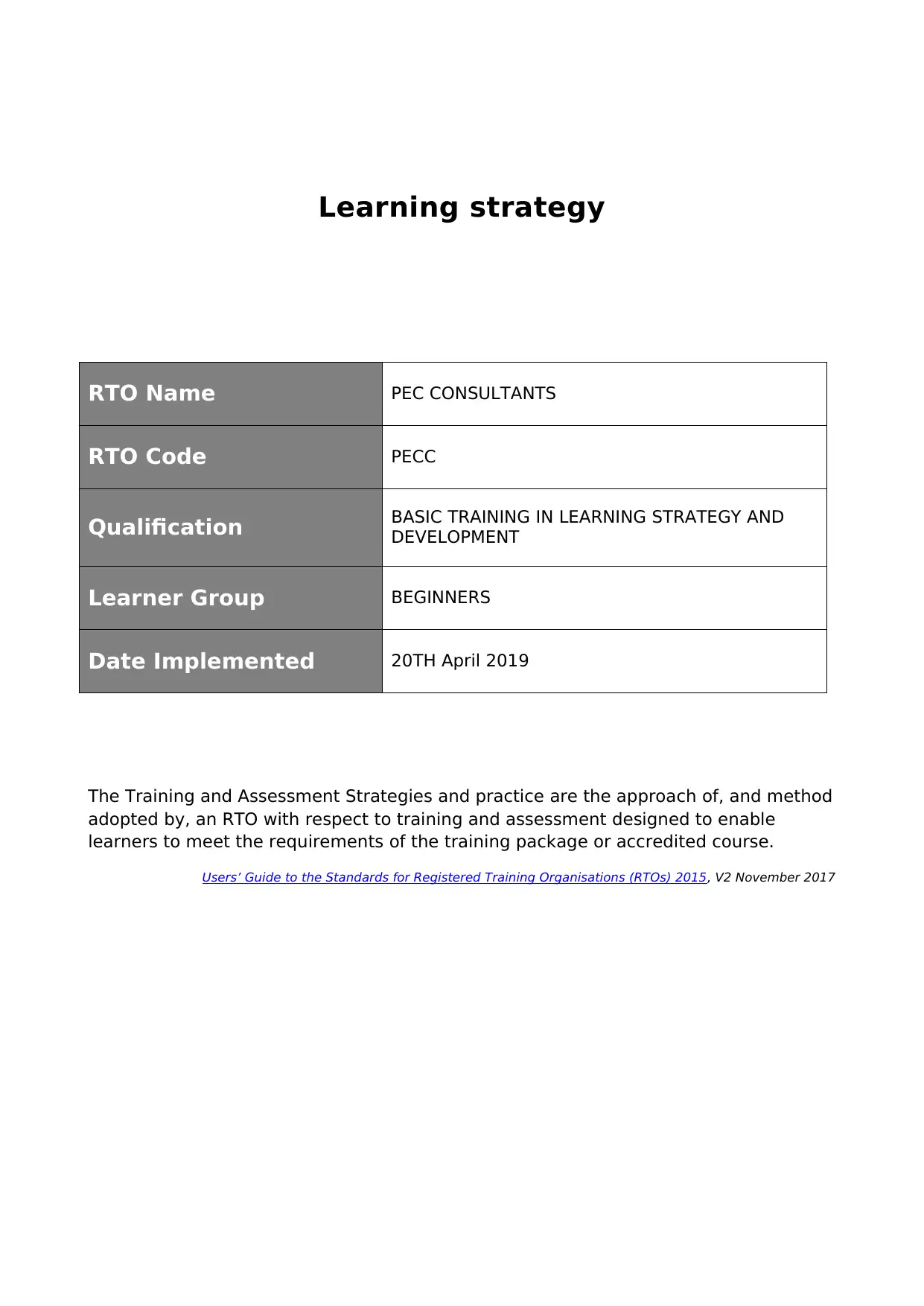
Learning strategy
RTO Name PEC CONSULTANTS
RTO Code PECC
Qualification BASIC TRAINING IN LEARNING STRATEGY AND
DEVELOPMENT
Learner Group BEGINNERS
Date Implemented 20TH April 2019
The Training and Assessment Strategies and practice are the approach of, and method
adopted by, an RTO with respect to training and assessment designed to enable
learners to meet the requirements of the training package or accredited course.
Users’ Guide to the Standards for Registered Training Organisations (RTOs) 2015, V2 November 2017
RTO Name PEC CONSULTANTS
RTO Code PECC
Qualification BASIC TRAINING IN LEARNING STRATEGY AND
DEVELOPMENT
Learner Group BEGINNERS
Date Implemented 20TH April 2019
The Training and Assessment Strategies and practice are the approach of, and method
adopted by, an RTO with respect to training and assessment designed to enable
learners to meet the requirements of the training package or accredited course.
Users’ Guide to the Standards for Registered Training Organisations (RTOs) 2015, V2 November 2017
Paraphrase This Document
Need a fresh take? Get an instant paraphrase of this document with our AI Paraphraser
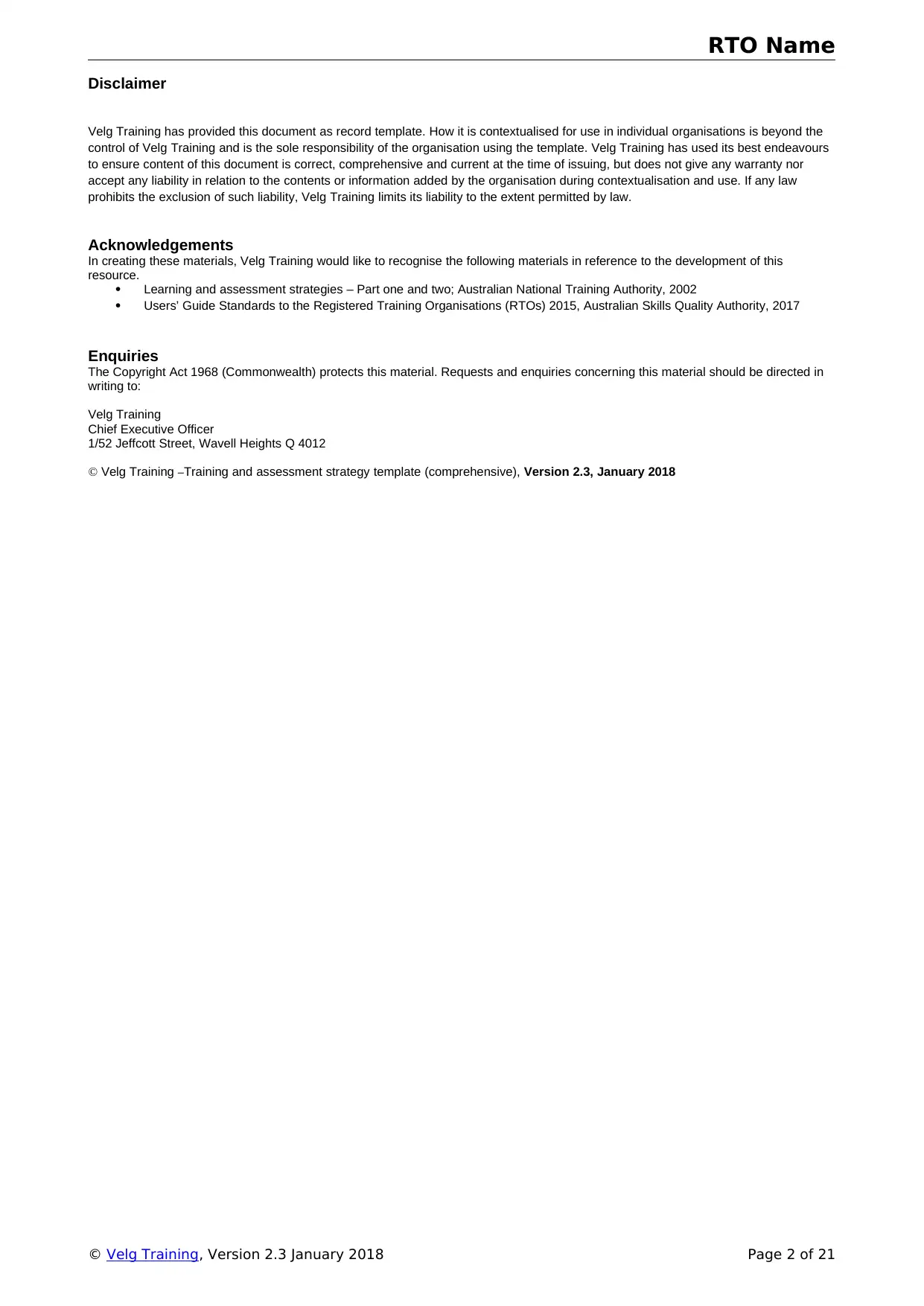
RTO Name
Disclaimer
Velg Training has provided this document as record template. How it is contextualised for use in individual organisations is beyond the
control of Velg Training and is the sole responsibility of the organisation using the template. Velg Training has used its best endeavours
to ensure content of this document is correct, comprehensive and current at the time of issuing, but does not give any warranty nor
accept any liability in relation to the contents or information added by the organisation during contextualisation and use. If any law
prohibits the exclusion of such liability, Velg Training limits its liability to the extent permitted by law.
Acknowledgements
In creating these materials, Velg Training would like to recognise the following materials in reference to the development of this
resource.
Learning and assessment strategies – Part one and two; Australian National Training Authority, 2002
Users’ Guide Standards to the Registered Training Organisations (RTOs) 2015, Australian Skills Quality Authority, 2017
Enquiries
The Copyright Act 1968 (Commonwealth) protects this material. Requests and enquiries concerning this material should be directed in
writing to:
Velg Training
Chief Executive Officer
1/52 Jeffcott Street, Wavell Heights Q 4012
Velg Training –Training and assessment strategy template (comprehensive), Version 2.3, January 2018
© Velg Training, Version 2.3 January 2018 Page 2 of 21
Disclaimer
Velg Training has provided this document as record template. How it is contextualised for use in individual organisations is beyond the
control of Velg Training and is the sole responsibility of the organisation using the template. Velg Training has used its best endeavours
to ensure content of this document is correct, comprehensive and current at the time of issuing, but does not give any warranty nor
accept any liability in relation to the contents or information added by the organisation during contextualisation and use. If any law
prohibits the exclusion of such liability, Velg Training limits its liability to the extent permitted by law.
Acknowledgements
In creating these materials, Velg Training would like to recognise the following materials in reference to the development of this
resource.
Learning and assessment strategies – Part one and two; Australian National Training Authority, 2002
Users’ Guide Standards to the Registered Training Organisations (RTOs) 2015, Australian Skills Quality Authority, 2017
Enquiries
The Copyright Act 1968 (Commonwealth) protects this material. Requests and enquiries concerning this material should be directed in
writing to:
Velg Training
Chief Executive Officer
1/52 Jeffcott Street, Wavell Heights Q 4012
Velg Training –Training and assessment strategy template (comprehensive), Version 2.3, January 2018
© Velg Training, Version 2.3 January 2018 Page 2 of 21
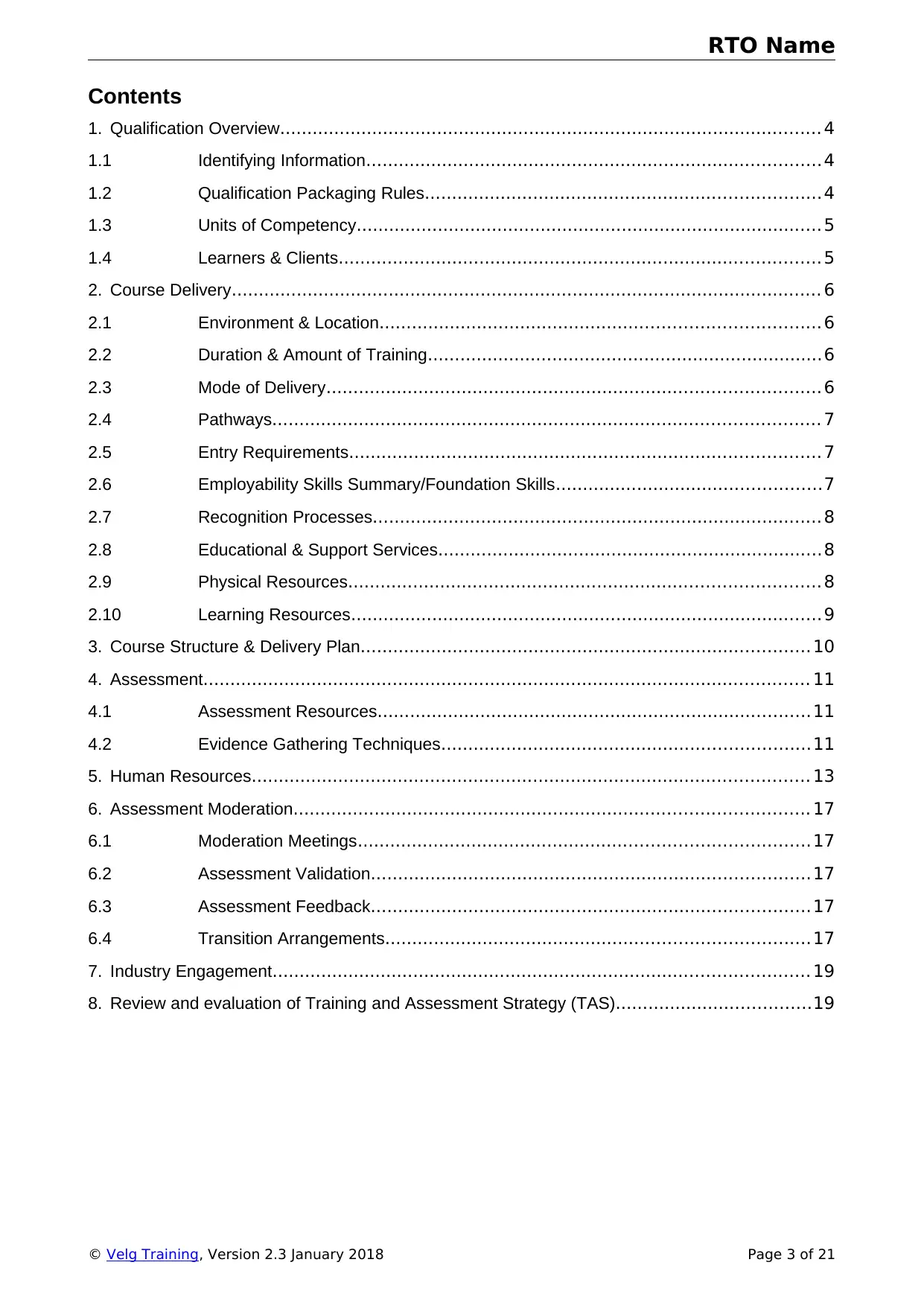
RTO Name
Contents
1. Qualification Overview.................................................................................................... 4
1.1 Identifying Information....................................................................................4
1.2 Qualification Packaging Rules.........................................................................4
1.3 Units of Competency...................................................................................... 5
1.4 Learners & Clients......................................................................................... 5
2. Course Delivery............................................................................................................. 6
2.1 Environment & Location................................................................................. 6
2.2 Duration & Amount of Training.........................................................................6
2.3 Mode of Delivery........................................................................................... 6
2.4 Pathways..................................................................................................... 7
2.5 Entry Requirements....................................................................................... 7
2.6 Employability Skills Summary/Foundation Skills.................................................7
2.7 Recognition Processes................................................................................... 8
2.8 Educational & Support Services.......................................................................8
2.9 Physical Resources....................................................................................... 8
2.10 Learning Resources....................................................................................... 9
3. Course Structure & Delivery Plan................................................................................... 10
4. Assessment................................................................................................................ 11
4.1 Assessment Resources................................................................................11
4.2 Evidence Gathering Techniques....................................................................11
5. Human Resources....................................................................................................... 13
6. Assessment Moderation............................................................................................... 17
6.1 Moderation Meetings...................................................................................17
6.2 Assessment Validation.................................................................................17
6.3 Assessment Feedback.................................................................................17
6.4 Transition Arrangements..............................................................................17
7. Industry Engagement................................................................................................... 19
8. Review and evaluation of Training and Assessment Strategy (TAS)....................................19
© Velg Training, Version 2.3 January 2018 Page 3 of 21
Contents
1. Qualification Overview.................................................................................................... 4
1.1 Identifying Information....................................................................................4
1.2 Qualification Packaging Rules.........................................................................4
1.3 Units of Competency...................................................................................... 5
1.4 Learners & Clients......................................................................................... 5
2. Course Delivery............................................................................................................. 6
2.1 Environment & Location................................................................................. 6
2.2 Duration & Amount of Training.........................................................................6
2.3 Mode of Delivery........................................................................................... 6
2.4 Pathways..................................................................................................... 7
2.5 Entry Requirements....................................................................................... 7
2.6 Employability Skills Summary/Foundation Skills.................................................7
2.7 Recognition Processes................................................................................... 8
2.8 Educational & Support Services.......................................................................8
2.9 Physical Resources....................................................................................... 8
2.10 Learning Resources....................................................................................... 9
3. Course Structure & Delivery Plan................................................................................... 10
4. Assessment................................................................................................................ 11
4.1 Assessment Resources................................................................................11
4.2 Evidence Gathering Techniques....................................................................11
5. Human Resources....................................................................................................... 13
6. Assessment Moderation............................................................................................... 17
6.1 Moderation Meetings...................................................................................17
6.2 Assessment Validation.................................................................................17
6.3 Assessment Feedback.................................................................................17
6.4 Transition Arrangements..............................................................................17
7. Industry Engagement................................................................................................... 19
8. Review and evaluation of Training and Assessment Strategy (TAS)....................................19
© Velg Training, Version 2.3 January 2018 Page 3 of 21
⊘ This is a preview!⊘
Do you want full access?
Subscribe today to unlock all pages.

Trusted by 1+ million students worldwide

RTO Name
1. Qualification Overview
1.1 Identifying Information
This section states the information identifying the RTO and the training products, as well as
the person authorising the use of the strategy document.
RTO Name PEC Consultants
RTO Code PECC
Training Package Code 7021
Training Package Title 7022
Version (Release) of Training
Package Beginner Status
Current ☐yes
Superseded ☐
Link to Training Package NA
Link to Companion Volumes NA
Qualification Code 7045
Qualification Title Basic Training in Leadership Learning and Development
Delivery Period 1st May to 1th May 2019
Contact Person Ron Mathew
Contact Details 16/2 Mansfield Road. Brisbane, Australia
Authorised By Ben Johnson
1.2 Qualification Packaging Rules
Based on information available from www.training.gov.authe following packaging rules
apply for completion of this qualification:
Total Number of Units 20
Number of Core Units 30
Number of Elective Units 15
Link to Packaging Rules NA
Other notes (imported units, levels of
units, etc.) NA
© Velg Training, Version 2.3 January 2018 Page 4 of 21
1. Qualification Overview
1.1 Identifying Information
This section states the information identifying the RTO and the training products, as well as
the person authorising the use of the strategy document.
RTO Name PEC Consultants
RTO Code PECC
Training Package Code 7021
Training Package Title 7022
Version (Release) of Training
Package Beginner Status
Current ☐yes
Superseded ☐
Link to Training Package NA
Link to Companion Volumes NA
Qualification Code 7045
Qualification Title Basic Training in Leadership Learning and Development
Delivery Period 1st May to 1th May 2019
Contact Person Ron Mathew
Contact Details 16/2 Mansfield Road. Brisbane, Australia
Authorised By Ben Johnson
1.2 Qualification Packaging Rules
Based on information available from www.training.gov.authe following packaging rules
apply for completion of this qualification:
Total Number of Units 20
Number of Core Units 30
Number of Elective Units 15
Link to Packaging Rules NA
Other notes (imported units, levels of
units, etc.) NA
© Velg Training, Version 2.3 January 2018 Page 4 of 21
Paraphrase This Document
Need a fresh take? Get an instant paraphrase of this document with our AI Paraphraser
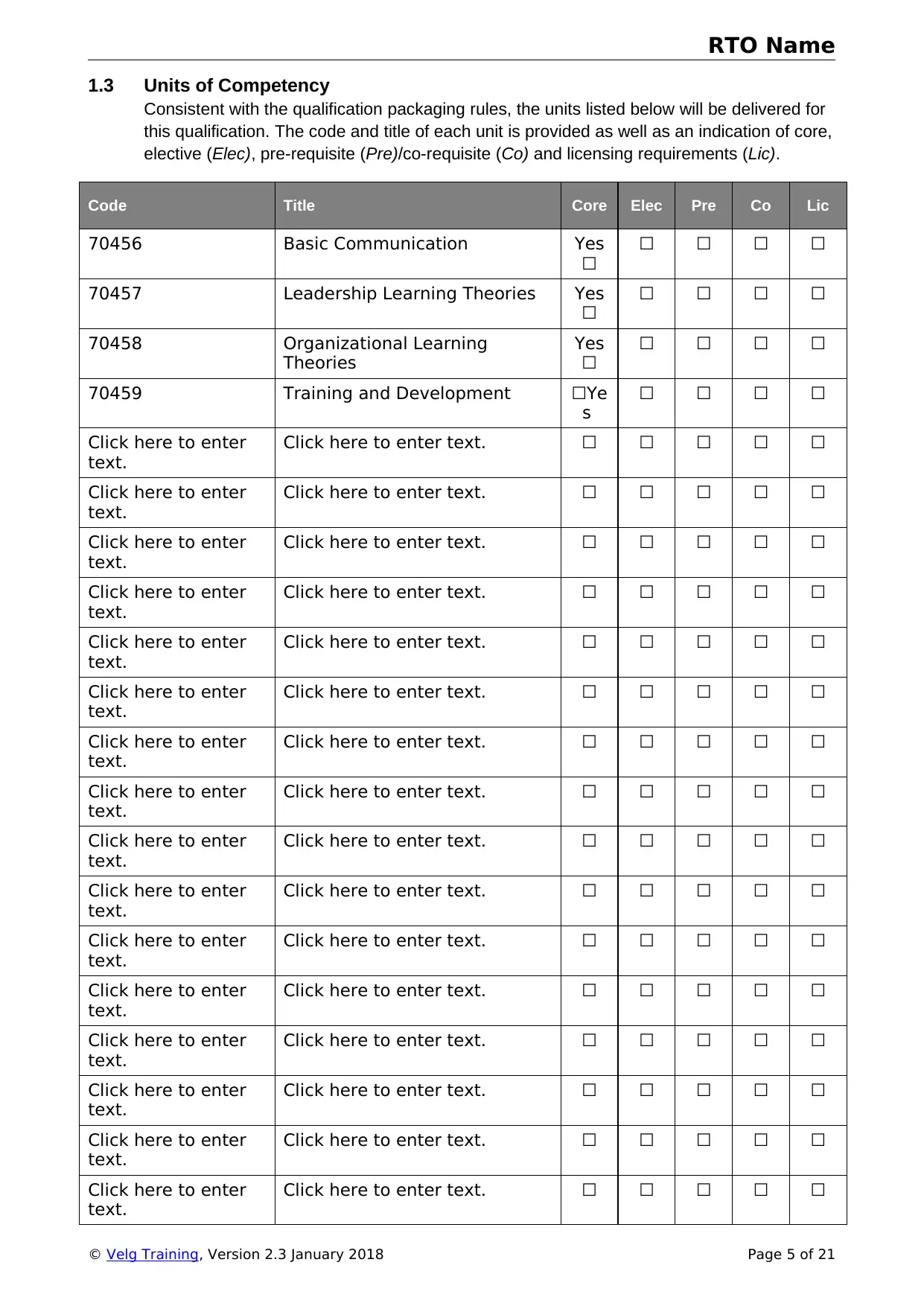
RTO Name
1.3 Units of Competency
Consistent with the qualification packaging rules, the units listed below will be delivered for
this qualification. The code and title of each unit is provided as well as an indication of core,
elective (Elec), pre-requisite (Pre)/co-requisite (Co) and licensing requirements (Lic).
Code Title Core Elec Pre Co Lic
70456 Basic Communication Yes
☐
☐ ☐ ☐ ☐
70457 Leadership Learning Theories Yes
☐
☐ ☐ ☐ ☐
70458 Organizational Learning
Theories
Yes
☐
☐ ☐ ☐ ☐
70459 Training and Development ☐Ye
s
☐ ☐ ☐ ☐
Click here to enter
text.
Click here to enter text. ☐ ☐ ☐ ☐ ☐
Click here to enter
text.
Click here to enter text. ☐ ☐ ☐ ☐ ☐
Click here to enter
text.
Click here to enter text. ☐ ☐ ☐ ☐ ☐
Click here to enter
text.
Click here to enter text. ☐ ☐ ☐ ☐ ☐
Click here to enter
text.
Click here to enter text. ☐ ☐ ☐ ☐ ☐
Click here to enter
text.
Click here to enter text. ☐ ☐ ☐ ☐ ☐
Click here to enter
text.
Click here to enter text. ☐ ☐ ☐ ☐ ☐
Click here to enter
text.
Click here to enter text. ☐ ☐ ☐ ☐ ☐
Click here to enter
text.
Click here to enter text. ☐ ☐ ☐ ☐ ☐
Click here to enter
text.
Click here to enter text. ☐ ☐ ☐ ☐ ☐
Click here to enter
text.
Click here to enter text. ☐ ☐ ☐ ☐ ☐
Click here to enter
text.
Click here to enter text. ☐ ☐ ☐ ☐ ☐
Click here to enter
text.
Click here to enter text. ☐ ☐ ☐ ☐ ☐
Click here to enter
text.
Click here to enter text. ☐ ☐ ☐ ☐ ☐
Click here to enter
text.
Click here to enter text. ☐ ☐ ☐ ☐ ☐
Click here to enter
text.
Click here to enter text. ☐ ☐ ☐ ☐ ☐
© Velg Training, Version 2.3 January 2018 Page 5 of 21
1.3 Units of Competency
Consistent with the qualification packaging rules, the units listed below will be delivered for
this qualification. The code and title of each unit is provided as well as an indication of core,
elective (Elec), pre-requisite (Pre)/co-requisite (Co) and licensing requirements (Lic).
Code Title Core Elec Pre Co Lic
70456 Basic Communication Yes
☐
☐ ☐ ☐ ☐
70457 Leadership Learning Theories Yes
☐
☐ ☐ ☐ ☐
70458 Organizational Learning
Theories
Yes
☐
☐ ☐ ☐ ☐
70459 Training and Development ☐Ye
s
☐ ☐ ☐ ☐
Click here to enter
text.
Click here to enter text. ☐ ☐ ☐ ☐ ☐
Click here to enter
text.
Click here to enter text. ☐ ☐ ☐ ☐ ☐
Click here to enter
text.
Click here to enter text. ☐ ☐ ☐ ☐ ☐
Click here to enter
text.
Click here to enter text. ☐ ☐ ☐ ☐ ☐
Click here to enter
text.
Click here to enter text. ☐ ☐ ☐ ☐ ☐
Click here to enter
text.
Click here to enter text. ☐ ☐ ☐ ☐ ☐
Click here to enter
text.
Click here to enter text. ☐ ☐ ☐ ☐ ☐
Click here to enter
text.
Click here to enter text. ☐ ☐ ☐ ☐ ☐
Click here to enter
text.
Click here to enter text. ☐ ☐ ☐ ☐ ☐
Click here to enter
text.
Click here to enter text. ☐ ☐ ☐ ☐ ☐
Click here to enter
text.
Click here to enter text. ☐ ☐ ☐ ☐ ☐
Click here to enter
text.
Click here to enter text. ☐ ☐ ☐ ☐ ☐
Click here to enter
text.
Click here to enter text. ☐ ☐ ☐ ☐ ☐
Click here to enter
text.
Click here to enter text. ☐ ☐ ☐ ☐ ☐
Click here to enter
text.
Click here to enter text. ☐ ☐ ☐ ☐ ☐
Click here to enter
text.
Click here to enter text. ☐ ☐ ☐ ☐ ☐
© Velg Training, Version 2.3 January 2018 Page 5 of 21
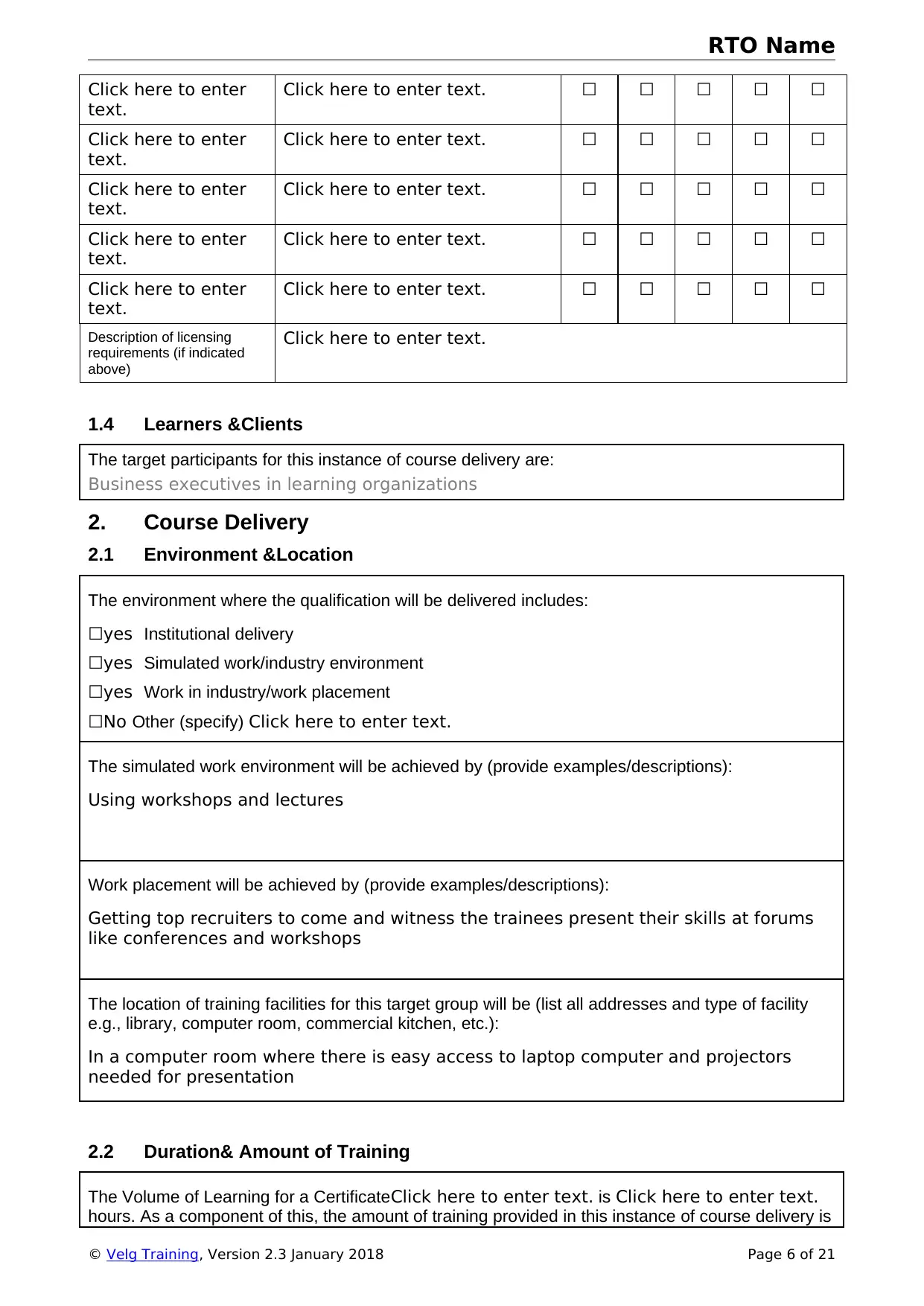
RTO Name
Click here to enter
text.
Click here to enter text. ☐ ☐ ☐ ☐ ☐
Click here to enter
text.
Click here to enter text. ☐ ☐ ☐ ☐ ☐
Click here to enter
text.
Click here to enter text. ☐ ☐ ☐ ☐ ☐
Click here to enter
text.
Click here to enter text. ☐ ☐ ☐ ☐ ☐
Click here to enter
text.
Click here to enter text. ☐ ☐ ☐ ☐ ☐
Description of licensing
requirements (if indicated
above)
Click here to enter text.
1.4 Learners &Clients
The target participants for this instance of course delivery are:
Business executives in learning organizations
2. Course Delivery
2.1 Environment &Location
The environment where the qualification will be delivered includes:
☐yes Institutional delivery
☐yes Simulated work/industry environment
☐yes Work in industry/work placement
☐No Other (specify) Click here to enter text.
The simulated work environment will be achieved by (provide examples/descriptions):
Using workshops and lectures
Work placement will be achieved by (provide examples/descriptions):
Getting top recruiters to come and witness the trainees present their skills at forums
like conferences and workshops
The location of training facilities for this target group will be (list all addresses and type of facility
e.g., library, computer room, commercial kitchen, etc.):
In a computer room where there is easy access to laptop computer and projectors
needed for presentation
2.2 Duration& Amount of Training
The Volume of Learning for a CertificateClick here to enter text. is Click here to enter text.
hours. As a component of this, the amount of training provided in this instance of course delivery is
© Velg Training, Version 2.3 January 2018 Page 6 of 21
Click here to enter
text.
Click here to enter text. ☐ ☐ ☐ ☐ ☐
Click here to enter
text.
Click here to enter text. ☐ ☐ ☐ ☐ ☐
Click here to enter
text.
Click here to enter text. ☐ ☐ ☐ ☐ ☐
Click here to enter
text.
Click here to enter text. ☐ ☐ ☐ ☐ ☐
Click here to enter
text.
Click here to enter text. ☐ ☐ ☐ ☐ ☐
Description of licensing
requirements (if indicated
above)
Click here to enter text.
1.4 Learners &Clients
The target participants for this instance of course delivery are:
Business executives in learning organizations
2. Course Delivery
2.1 Environment &Location
The environment where the qualification will be delivered includes:
☐yes Institutional delivery
☐yes Simulated work/industry environment
☐yes Work in industry/work placement
☐No Other (specify) Click here to enter text.
The simulated work environment will be achieved by (provide examples/descriptions):
Using workshops and lectures
Work placement will be achieved by (provide examples/descriptions):
Getting top recruiters to come and witness the trainees present their skills at forums
like conferences and workshops
The location of training facilities for this target group will be (list all addresses and type of facility
e.g., library, computer room, commercial kitchen, etc.):
In a computer room where there is easy access to laptop computer and projectors
needed for presentation
2.2 Duration& Amount of Training
The Volume of Learning for a CertificateClick here to enter text. is Click here to enter text.
hours. As a component of this, the amount of training provided in this instance of course delivery is
© Velg Training, Version 2.3 January 2018 Page 6 of 21
⊘ This is a preview!⊘
Do you want full access?
Subscribe today to unlock all pages.

Trusted by 1+ million students worldwide
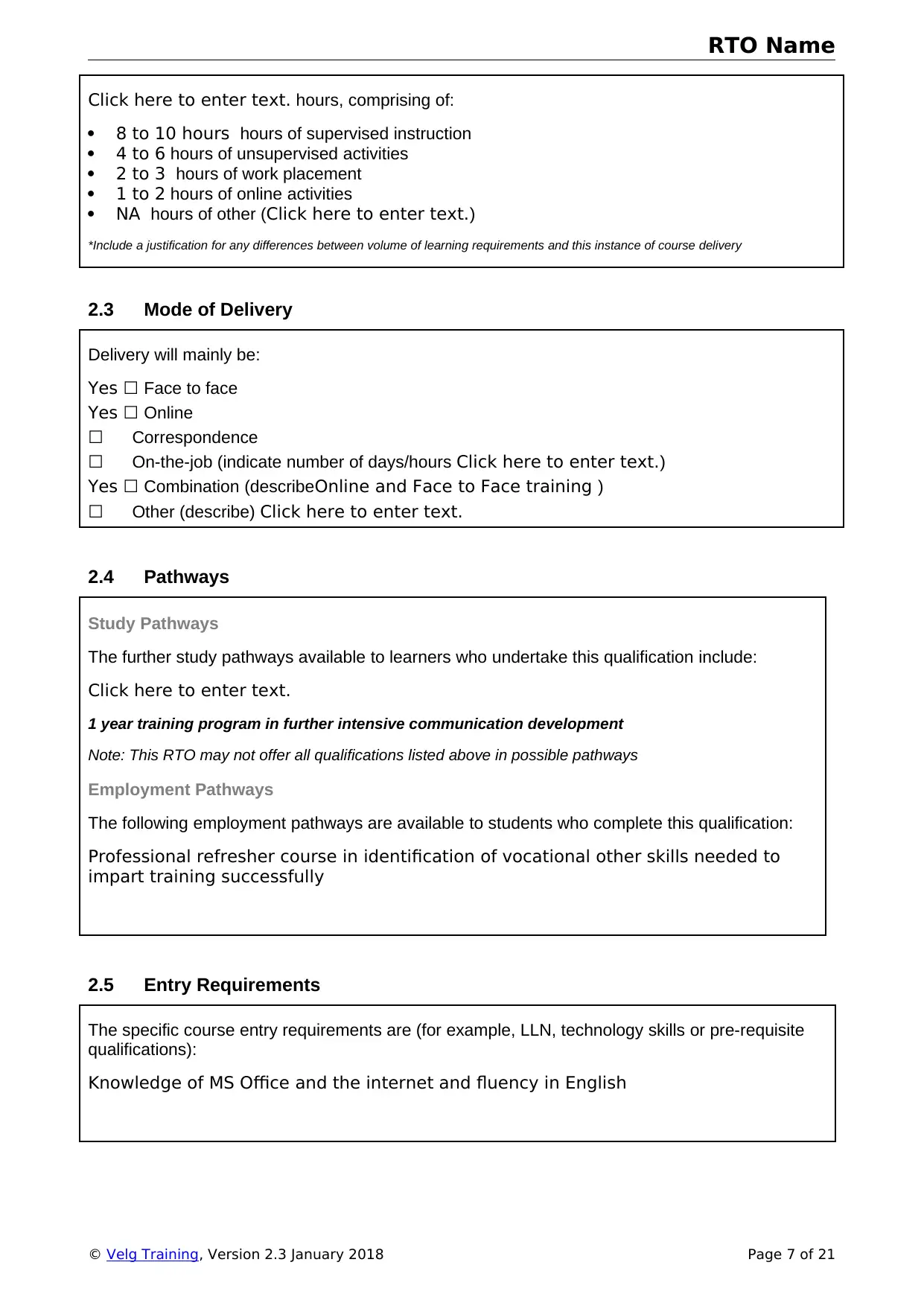
RTO Name
Click here to enter text. hours, comprising of:
8 to 10 hours hours of supervised instruction
4 to 6 hours of unsupervised activities
2 to 3 hours of work placement
1 to 2 hours of online activities
NA hours of other (Click here to enter text.)
*Include a justification for any differences between volume of learning requirements and this instance of course delivery
2.3 Mode of Delivery
Delivery will mainly be:
Yes ☐ Face to face
Yes ☐ Online
☐ Correspondence
☐ On-the-job (indicate number of days/hours Click here to enter text.)
Yes ☐ Combination (describeOnline and Face to Face training )
☐ Other (describe) Click here to enter text.
2.4 Pathways
Study Pathways
The further study pathways available to learners who undertake this qualification include:
Click here to enter text.
1 year training program in further intensive communication development
Note: This RTO may not offer all qualifications listed above in possible pathways
Employment Pathways
The following employment pathways are available to students who complete this qualification:
Professional refresher course in identification of vocational other skills needed to
impart training successfully
2.5 Entry Requirements
The specific course entry requirements are (for example, LLN, technology skills or pre-requisite
qualifications):
Knowledge of MS Office and the internet and fluency in English
© Velg Training, Version 2.3 January 2018 Page 7 of 21
Click here to enter text. hours, comprising of:
8 to 10 hours hours of supervised instruction
4 to 6 hours of unsupervised activities
2 to 3 hours of work placement
1 to 2 hours of online activities
NA hours of other (Click here to enter text.)
*Include a justification for any differences between volume of learning requirements and this instance of course delivery
2.3 Mode of Delivery
Delivery will mainly be:
Yes ☐ Face to face
Yes ☐ Online
☐ Correspondence
☐ On-the-job (indicate number of days/hours Click here to enter text.)
Yes ☐ Combination (describeOnline and Face to Face training )
☐ Other (describe) Click here to enter text.
2.4 Pathways
Study Pathways
The further study pathways available to learners who undertake this qualification include:
Click here to enter text.
1 year training program in further intensive communication development
Note: This RTO may not offer all qualifications listed above in possible pathways
Employment Pathways
The following employment pathways are available to students who complete this qualification:
Professional refresher course in identification of vocational other skills needed to
impart training successfully
2.5 Entry Requirements
The specific course entry requirements are (for example, LLN, technology skills or pre-requisite
qualifications):
Knowledge of MS Office and the internet and fluency in English
© Velg Training, Version 2.3 January 2018 Page 7 of 21
Paraphrase This Document
Need a fresh take? Get an instant paraphrase of this document with our AI Paraphraser
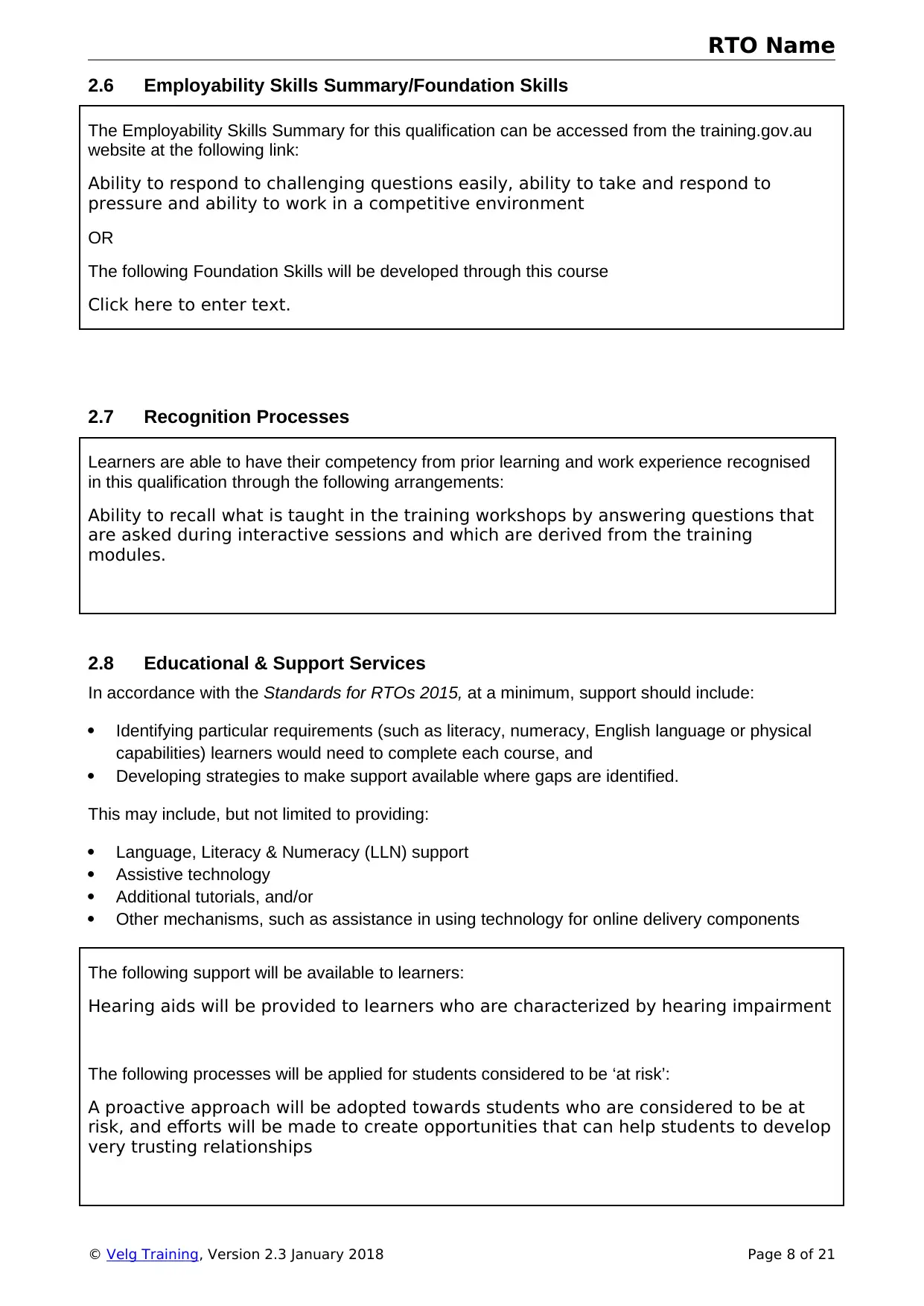
RTO Name
2.6 Employability Skills Summary/Foundation Skills
The Employability Skills Summary for this qualification can be accessed from the training.gov.au
website at the following link:
Ability to respond to challenging questions easily, ability to take and respond to
pressure and ability to work in a competitive environment
OR
The following Foundation Skills will be developed through this course
Click here to enter text.
2.7 Recognition Processes
Learners are able to have their competency from prior learning and work experience recognised
in this qualification through the following arrangements:
Ability to recall what is taught in the training workshops by answering questions that
are asked during interactive sessions and which are derived from the training
modules.
2.8 Educational & Support Services
In accordance with the Standards for RTOs 2015, at a minimum, support should include:
Identifying particular requirements (such as literacy, numeracy, English language or physical
capabilities) learners would need to complete each course, and
Developing strategies to make support available where gaps are identified.
This may include, but not limited to providing:
Language, Literacy & Numeracy (LLN) support
Assistive technology
Additional tutorials, and/or
Other mechanisms, such as assistance in using technology for online delivery components
The following support will be available to learners:
Hearing aids will be provided to learners who are characterized by hearing impairment
The following processes will be applied for students considered to be ‘at risk’:
A proactive approach will be adopted towards students who are considered to be at
risk, and efforts will be made to create opportunities that can help students to develop
very trusting relationships
© Velg Training, Version 2.3 January 2018 Page 8 of 21
2.6 Employability Skills Summary/Foundation Skills
The Employability Skills Summary for this qualification can be accessed from the training.gov.au
website at the following link:
Ability to respond to challenging questions easily, ability to take and respond to
pressure and ability to work in a competitive environment
OR
The following Foundation Skills will be developed through this course
Click here to enter text.
2.7 Recognition Processes
Learners are able to have their competency from prior learning and work experience recognised
in this qualification through the following arrangements:
Ability to recall what is taught in the training workshops by answering questions that
are asked during interactive sessions and which are derived from the training
modules.
2.8 Educational & Support Services
In accordance with the Standards for RTOs 2015, at a minimum, support should include:
Identifying particular requirements (such as literacy, numeracy, English language or physical
capabilities) learners would need to complete each course, and
Developing strategies to make support available where gaps are identified.
This may include, but not limited to providing:
Language, Literacy & Numeracy (LLN) support
Assistive technology
Additional tutorials, and/or
Other mechanisms, such as assistance in using technology for online delivery components
The following support will be available to learners:
Hearing aids will be provided to learners who are characterized by hearing impairment
The following processes will be applied for students considered to be ‘at risk’:
A proactive approach will be adopted towards students who are considered to be at
risk, and efforts will be made to create opportunities that can help students to develop
very trusting relationships
© Velg Training, Version 2.3 January 2018 Page 8 of 21

RTO Name
2.9 Physical Resources
All staff involved in the delivery and assessment of this qualification have:
Yes ☐ Direct access to the current version of the units of competency, assessment requirements,
relevant Training Package and companion volumes
☐Yes Access to appropriate support materials relevant to their areas of delivery and
assessment
☐Yes Access to the latest copy of assessment tools used for this program
Yes ☐ Access to training and assessment resources to meet the requirements of learners with
special needs including procedures for making reasonable adjustments to the assessment
process
☐Yes Access to equipment and facilities to meet the requirements of each unit of competency
and successfully implement the program (further information provided below).
Specifically, the following physical resources are available for the delivery and assessment of the
units of competency selected for this qualification. Where there is more than one training location,
specify the location for the specific resources.(If there is not sufficient space, indicate where to find a
comprehensive listing of resources).
NA
The following physical resources owned by external organisations are available for use during
delivery and assessment, and a Third Party Agreement outlining the details of this arrangement is
in the following location:
Laptop computers
2.10 Learning Resources
The following learning resources will be available to ensure learners are able to obtain and absorb
the required skills and knowledge required prior to assessment:
Internet access including access to e-textbooks on training and development
© Velg Training, Version 2.3 January 2018 Page 9 of 21
2.9 Physical Resources
All staff involved in the delivery and assessment of this qualification have:
Yes ☐ Direct access to the current version of the units of competency, assessment requirements,
relevant Training Package and companion volumes
☐Yes Access to appropriate support materials relevant to their areas of delivery and
assessment
☐Yes Access to the latest copy of assessment tools used for this program
Yes ☐ Access to training and assessment resources to meet the requirements of learners with
special needs including procedures for making reasonable adjustments to the assessment
process
☐Yes Access to equipment and facilities to meet the requirements of each unit of competency
and successfully implement the program (further information provided below).
Specifically, the following physical resources are available for the delivery and assessment of the
units of competency selected for this qualification. Where there is more than one training location,
specify the location for the specific resources.(If there is not sufficient space, indicate where to find a
comprehensive listing of resources).
NA
The following physical resources owned by external organisations are available for use during
delivery and assessment, and a Third Party Agreement outlining the details of this arrangement is
in the following location:
Laptop computers
2.10 Learning Resources
The following learning resources will be available to ensure learners are able to obtain and absorb
the required skills and knowledge required prior to assessment:
Internet access including access to e-textbooks on training and development
© Velg Training, Version 2.3 January 2018 Page 9 of 21
⊘ This is a preview!⊘
Do you want full access?
Subscribe today to unlock all pages.

Trusted by 1+ million students worldwide
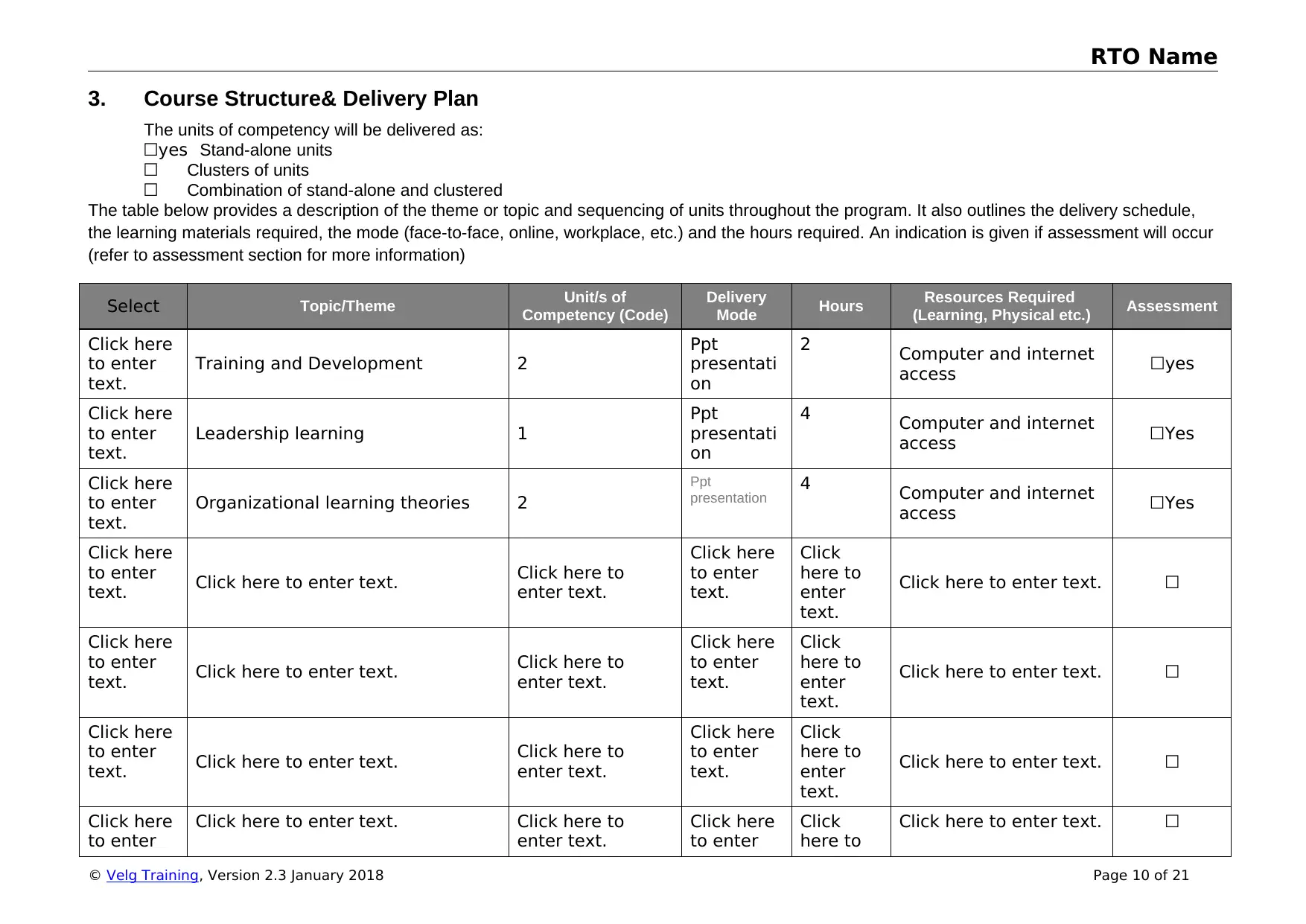
RTO Name
3. Course Structure& Delivery Plan
The units of competency will be delivered as:
☐yes Stand-alone units
☐ Clusters of units
☐ Combination of stand-alone and clustered
The table below provides a description of the theme or topic and sequencing of units throughout the program. It also outlines the delivery schedule,
the learning materials required, the mode (face-to-face, online, workplace, etc.) and the hours required. An indication is given if assessment will occur
(refer to assessment section for more information)
Select Topic/Theme Unit/s of
Competency (Code)
Delivery
Mode Hours Resources Required
(Learning, Physical etc.) Assessment
Click here
to enter
text.
Training and Development 2
Ppt
presentati
on
2 Computer and internet
access ☐yes
Click here
to enter
text.
Leadership learning 1
Ppt
presentati
on
4 Computer and internet
access ☐Yes
Click here
to enter
text.
Organizational learning theories 2
Ppt
presentation 4 Computer and internet
access ☐Yes
Click here
to enter
text. Click here to enter text. Click here to
enter text.
Click here
to enter
text.
Click
here to
enter
text.
Click here to enter text. ☐
Click here
to enter
text. Click here to enter text. Click here to
enter text.
Click here
to enter
text.
Click
here to
enter
text.
Click here to enter text. ☐
Click here
to enter
text. Click here to enter text. Click here to
enter text.
Click here
to enter
text.
Click
here to
enter
text.
Click here to enter text. ☐
Click here
to enter
Click here to enter text. Click here to
enter text.
Click here
to enter
Click
here to
Click here to enter text. ☐
© Velg Training, Version 2.3 January 2018 Page 10 of 21
3. Course Structure& Delivery Plan
The units of competency will be delivered as:
☐yes Stand-alone units
☐ Clusters of units
☐ Combination of stand-alone and clustered
The table below provides a description of the theme or topic and sequencing of units throughout the program. It also outlines the delivery schedule,
the learning materials required, the mode (face-to-face, online, workplace, etc.) and the hours required. An indication is given if assessment will occur
(refer to assessment section for more information)
Select Topic/Theme Unit/s of
Competency (Code)
Delivery
Mode Hours Resources Required
(Learning, Physical etc.) Assessment
Click here
to enter
text.
Training and Development 2
Ppt
presentati
on
2 Computer and internet
access ☐yes
Click here
to enter
text.
Leadership learning 1
Ppt
presentati
on
4 Computer and internet
access ☐Yes
Click here
to enter
text.
Organizational learning theories 2
Ppt
presentation 4 Computer and internet
access ☐Yes
Click here
to enter
text. Click here to enter text. Click here to
enter text.
Click here
to enter
text.
Click
here to
enter
text.
Click here to enter text. ☐
Click here
to enter
text. Click here to enter text. Click here to
enter text.
Click here
to enter
text.
Click
here to
enter
text.
Click here to enter text. ☐
Click here
to enter
text. Click here to enter text. Click here to
enter text.
Click here
to enter
text.
Click
here to
enter
text.
Click here to enter text. ☐
Click here
to enter
Click here to enter text. Click here to
enter text.
Click here
to enter
Click
here to
Click here to enter text. ☐
© Velg Training, Version 2.3 January 2018 Page 10 of 21
Paraphrase This Document
Need a fresh take? Get an instant paraphrase of this document with our AI Paraphraser
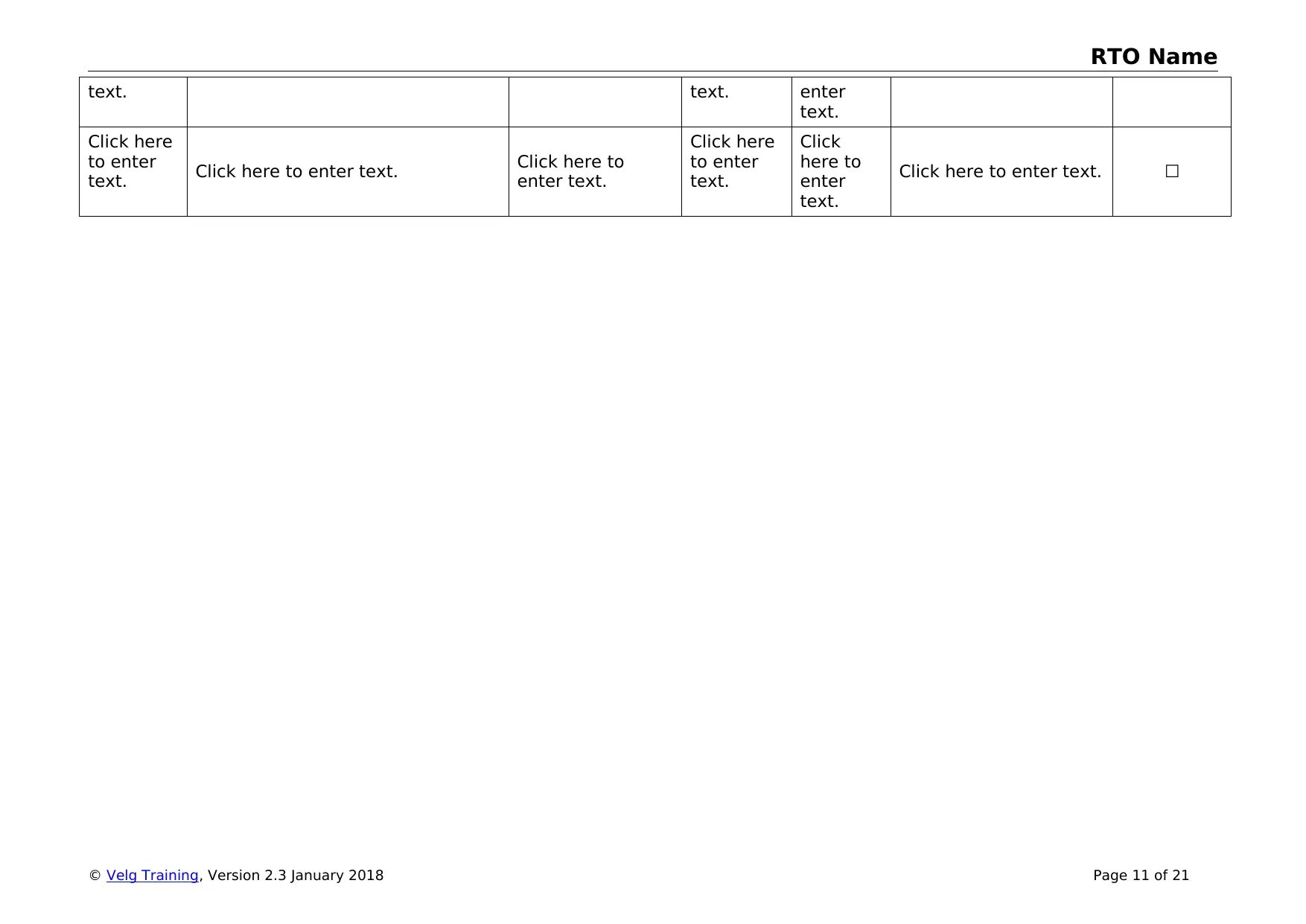
RTO Name
text. text. enter
text.
Click here
to enter
text. Click here to enter text. Click here to
enter text.
Click here
to enter
text.
Click
here to
enter
text.
Click here to enter text. ☐
© Velg Training, Version 2.3 January 2018 Page 11 of 21
text. text. enter
text.
Click here
to enter
text. Click here to enter text. Click here to
enter text.
Click here
to enter
text.
Click
here to
enter
text.
Click here to enter text. ☐
© Velg Training, Version 2.3 January 2018 Page 11 of 21

RTO Name
4. Assessment
4.1 Assessment Resources
that will be used are: Click here to enter text.
4.2 Evidence Gathering Techniques
The following table provides a general overview of the evidence gathering techniques that will be used to assess each unit
of competency. A range of assessment techniquesare outlined in the table below to gather sufficient evidence, in a range of
contexts, to meet the requirements of the training package and make a decision regarding competence.
More detailed information regarding the assessment of each unit of competency, including timing and resourcescan be found in the
assessment planners for each unit which are saved on the network in the following location: Click here to enter text.
Technique Legend
Examples of assessment techniques may include, but not limited to observation of performance, questioning, workbooks, practical tasks, simulation,
interviews, third party reports, etc. The assessment techniquesused for this qualification and target group are as follows:
A Performance observation
B Workbooks
C Questioning
D Click here to enter text.
E Click here to enter text.
F Click here to enter text.
Assessment Matrix
Unit Code Unit Title
Technique (refer to legend)
A B C D E F Notes regarding timing and
specific resources required
70456 Basic Communication Yes
☐ ☐ ☐ ☐ ☐ ☐ Click here to enter text.
70457 Leadership learning theories ☐ye
s
Yes
☐ ☐ ☐ ☐ ☐ Click here to enter text.
70458 Organizational learning theories ☐ye Yes Yes ☐ ☐ ☐ Click here to enter text.
© Velg Training, Version 2.3 January 2018 Page 12 of 21
4. Assessment
4.1 Assessment Resources
that will be used are: Click here to enter text.
4.2 Evidence Gathering Techniques
The following table provides a general overview of the evidence gathering techniques that will be used to assess each unit
of competency. A range of assessment techniquesare outlined in the table below to gather sufficient evidence, in a range of
contexts, to meet the requirements of the training package and make a decision regarding competence.
More detailed information regarding the assessment of each unit of competency, including timing and resourcescan be found in the
assessment planners for each unit which are saved on the network in the following location: Click here to enter text.
Technique Legend
Examples of assessment techniques may include, but not limited to observation of performance, questioning, workbooks, practical tasks, simulation,
interviews, third party reports, etc. The assessment techniquesused for this qualification and target group are as follows:
A Performance observation
B Workbooks
C Questioning
D Click here to enter text.
E Click here to enter text.
F Click here to enter text.
Assessment Matrix
Unit Code Unit Title
Technique (refer to legend)
A B C D E F Notes regarding timing and
specific resources required
70456 Basic Communication Yes
☐ ☐ ☐ ☐ ☐ ☐ Click here to enter text.
70457 Leadership learning theories ☐ye
s
Yes
☐ ☐ ☐ ☐ ☐ Click here to enter text.
70458 Organizational learning theories ☐ye Yes Yes ☐ ☐ ☐ Click here to enter text.
© Velg Training, Version 2.3 January 2018 Page 12 of 21
⊘ This is a preview!⊘
Do you want full access?
Subscribe today to unlock all pages.

Trusted by 1+ million students worldwide
1 out of 21
Related Documents
Your All-in-One AI-Powered Toolkit for Academic Success.
+13062052269
info@desklib.com
Available 24*7 on WhatsApp / Email
![[object Object]](/_next/static/media/star-bottom.7253800d.svg)
Unlock your academic potential
Copyright © 2020–2025 A2Z Services. All Rights Reserved. Developed and managed by ZUCOL.





